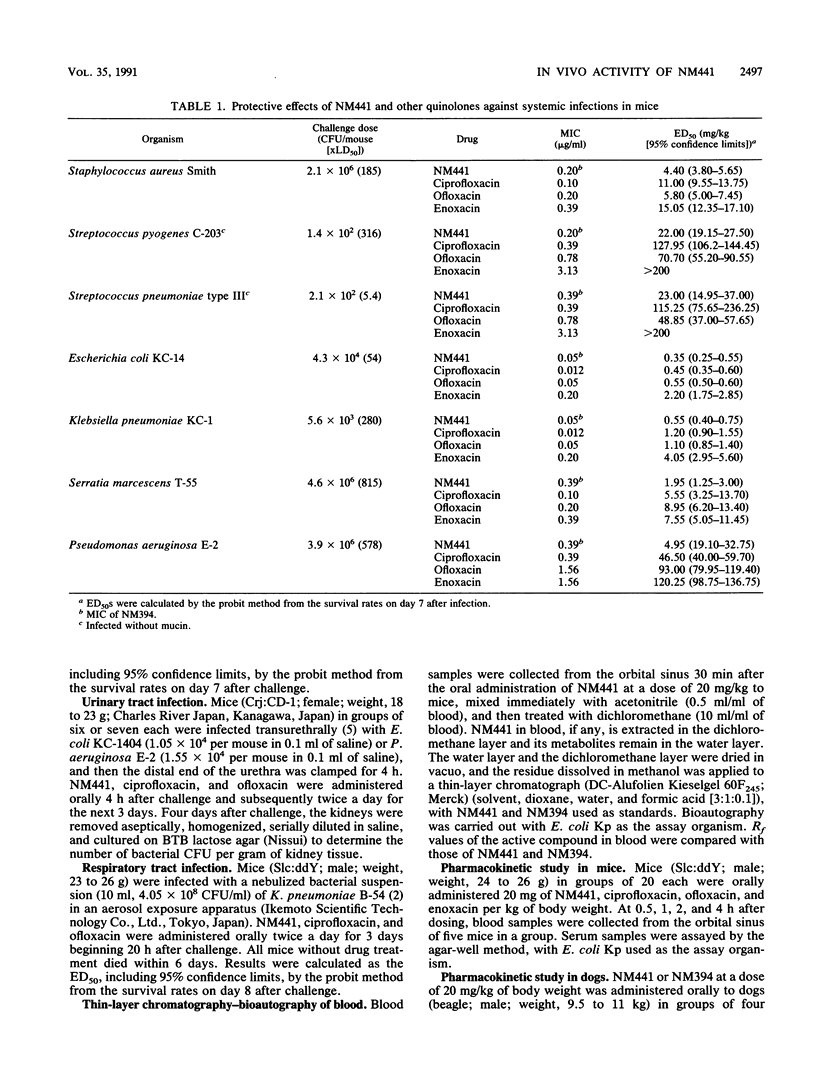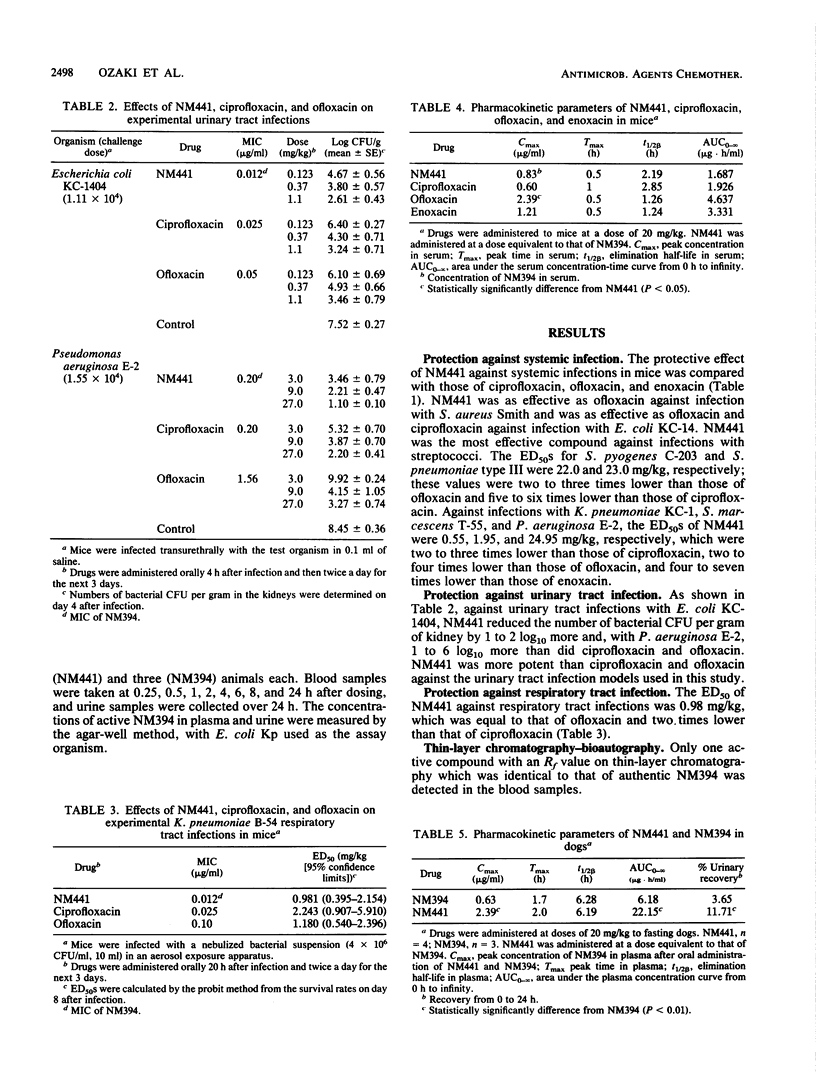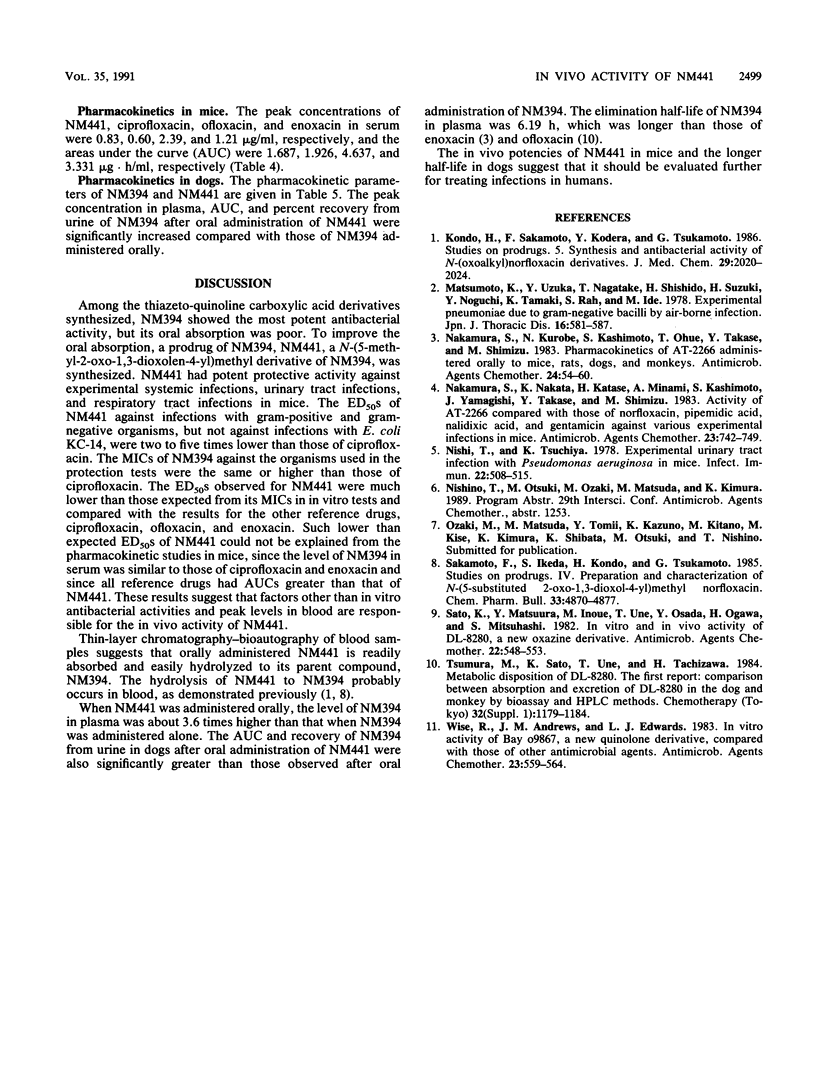Abstract
NM441 is a lipophilic prodrug of a new thiazeto-quinoline carboxylic acid derivative NM394, and when it is administered orally it is readily absorbed and hydrolyzed to its parent compound. After oral administration of NM441 at a dose of 20 mg/kg to dogs, the peak concentration of NM394 in plasma was 2.39 micrograms/ml, whereas it was 0.63 micrograms/ml for NM394 administered alone. The in vivo activity of NM441 was compared with those of ciprofloxacin, ofloxacin, and enoxacin in mouse protection studies. NM441 was as effective as ofloxacin and was twice as effective as ciprofloxacin against systemic infection with Staphylococcus aureus. Against infections with streptococci, NM441 was two to three times as effective as ofloxacin and five times as effective as ciprofloxacin. Against infection with Escherichia coli, NM441 was as effective as ciprofloxacin and ofloxacin, but against infections with Klebsiella pneumoniae, Serratia marcescens, and Pseudomonas aeruginosa, NM441 was two to four times as effective as ciprofloxacin and ofloxacin. NM441 was three to seven times as effective as enoxacin in systemic infections. Against urinary tract infections with E. coli, NM441 reduced the number of bacterial CFU per gram of kidney by 1 to 2 log10 more and, with P. aeruginosa, by 1 to 6 log10 more than did ciprofloxacin and ofloxacin. Against respiratory tract infections with K. pneumoniae, NM441 was as effective as ofloxacin and was twice as effective as ciprofloxacin.
Full text
PDF



Selected References
These references are in PubMed. This may not be the complete list of references from this article.
- Kondo H., Sakamoto F., Kodera Y., Tsukamoto G. Studies on prodrugs. 5. Synthesis and antimicrobial activity of N-(oxoalkyl)norfloxacin derivatives. J Med Chem. 1986 Oct;29(10):2020–2024. doi: 10.1021/jm00160a037. [DOI] [PubMed] [Google Scholar]
- Matsumoto K., Uzuka Y., Nagatake T., Shishido H., Suzuki H., Noguchi Y., Tamaki K., Rah S., Ide M. [Experimental pneumonia due to gram negative bacilli by air-borne infection (author's transl)]. Nihon Kyobu Shikkan Gakkai Zasshi. 1978 Aug;16(8):581–588. [PubMed] [Google Scholar]
- Nakamura S., Kurobe N., Kashimoto S., Ohue T., Takase Y., Shimizu M. Pharmacokinetics of AT-2266 administered orally to mice, rats, dogs, and monkeys. Antimicrob Agents Chemother. 1983 Jul;24(1):54–60. doi: 10.1128/aac.24.1.54. [DOI] [PMC free article] [PubMed] [Google Scholar]
- Nakamura S., Nakata K., Katae H., Minami A., Kashimoto S., Yamagishi J., Takase Y., Shimizu M. Activity of AT-2266 compared with those of norfloxacin, pipemidic acid, nalidixic acid, and gentamicin against various experimental infections in mice. Antimicrob Agents Chemother. 1983 May;23(5):742–749. doi: 10.1128/aac.23.5.742. [DOI] [PMC free article] [PubMed] [Google Scholar]
- Nishi T., Tsuchiya K. Experimental urinary tract infection with Pseudomonas aeruginosa in mice. Infect Immun. 1978 Nov;22(2):508–515. doi: 10.1128/iai.22.2.508-515.1978. [DOI] [PMC free article] [PubMed] [Google Scholar]
- Sakamoto F., Ikeda S., Kondo H., Tsukamoto G. Studies on prodrugs. IV. Preparation and characterization of N-(5-substituted 2-oxo-1,3-dioxol-4-yl)methyl norfloxacin. Chem Pharm Bull (Tokyo) 1985 Nov;33(11):4870–4877. doi: 10.1248/cpb.33.4870. [DOI] [PubMed] [Google Scholar]
- Sato K., Matsuura Y., Inoue M., Une T., Osada Y., Ogawa H., Mitsuhashi S. In vitro and in vivo activity of DL-8280, a new oxazine derivative. Antimicrob Agents Chemother. 1982 Oct;22(4):548–553. doi: 10.1128/aac.22.4.548. [DOI] [PMC free article] [PubMed] [Google Scholar]
- Wise R., Andrews J. M., Edwards L. J. In vitro activity of Bay 09867, a new quinoline derivative, compared with those of other antimicrobial agents. Antimicrob Agents Chemother. 1983 Apr;23(4):559–564. doi: 10.1128/aac.23.4.559. [DOI] [PMC free article] [PubMed] [Google Scholar]


